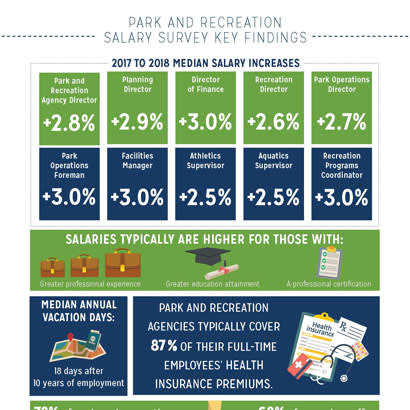
According to the U.S. Bureau of Labor Statistics, in 2015, there were more than 153,000 full-time employees of local park and recreation agencies in the United States. These individuals provide opportunities for people of all ages to experience the benefits of parks and recreation, including greater access to nature and the outdoors, and health and wellness programs that improve the health of communities overall.
Park and recreation agency leaders can determine how to attract the best staff when their decisions are informed by comprehensive compensation data. Conversely, this data also provides park and recreation professionals with insights on salary and benefits offerings from potential employers. This is where the NRPA Park and Recreation Salary Survey report comes in.
In April 2018, NRPA’s research team sent a 32-question survey to elicit not only the salary data of 10 positions at park and recreation agencies, but also about general information on benefits and salary policies. The survey generated responses from 714 park and recreation agencies across the United States, resulting in a 15 percent response rate.
The survey highlights salary and bonus data for park and recreation agency directors in the areas of planning, finance, recreation and park operations. The data included in the survey report includes detailed comparisons based on agency size, type and characteristics of the persons in the positions (e.g., education, certifications and years in the profession).
Based on the responses from 714 park and recreation agencies, the salary survey revealed the following:
- Salaries are typically higher for those with greater professional experience, greater education attainment and a professional certification, such as, NRPA’s Certified Park and Recreation Professional (CPRP) and Certified Park and Recreation Executive (CPRE) certifications
- Park and recreation agencies typically cover 87 percent of their full-time employees’ health insurance premiums
- The majority (78 percent) of park and recreation agencies offer their full-time employees a defined benefit retirement plan
- More than half (68 percent) of park and recreation agencies offer their full-time employees a defined contribution retirement plan
Typical 2017–2018 salary increases and median annual vacation days were also identified.
“Public support for parks and recreation is strong; therefore, compensation for the people who manage our local park and recreation centers should reflect that,” says Barbara Tulipane, CAE, NRPA president and CEO. “Agencies everywhere are encouraged to use this data as a benchmark to ensure their salaries and benefits are fair and competitive.”

